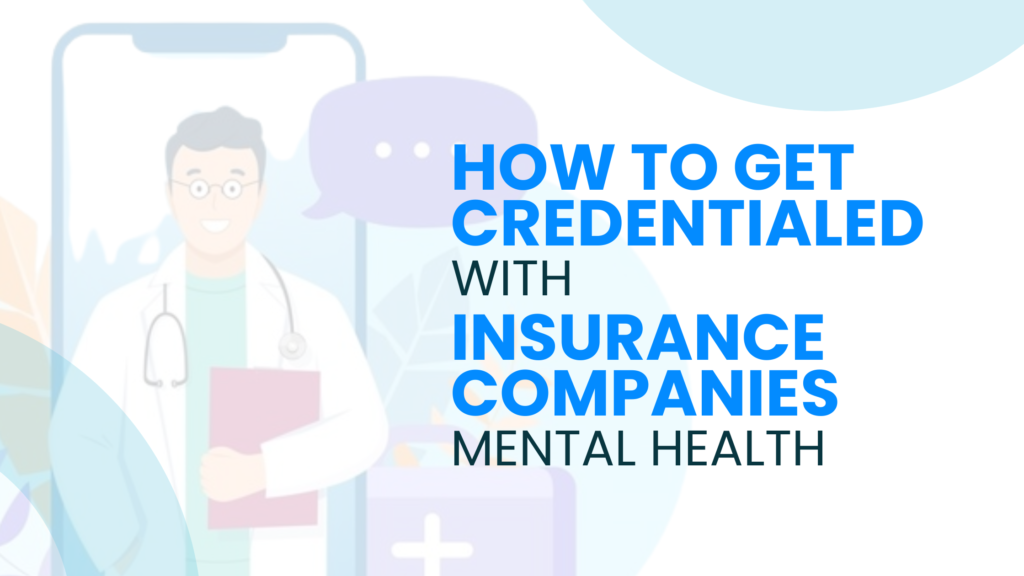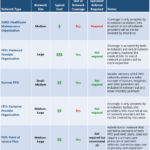Get Credentialed With Insurance: A Step‑by‑Step Guide for Mental Health Providers

Overview: What Credentialing Is and Why It Matters
Credentialing is the insurer’s verification process to approve you as an in‑network behavioral health provider, confirming your education, licensure, malpractice coverage, and practice information before you can bill their plans. Becoming in‑network can expand referrals, stabilize reimbursements, and reduce out‑of‑pocket costs for clients. Industry guidance notes credentialing typically takes 90-180 days per payer, depending on completeness and follow‑up [1] . Many payers rely on the CAQH ProView database to confirm your information; you must keep it current with periodic re-attestation [2] .
Step 1: Get Organized With the Right Documents
Assemble a complete, easy‑to‑verify packet before you contact payers. A practical list includes: current state license(s), malpractice/liability insurance, NPI, up‑to‑date CV (five‑year work history), Tax ID/EIN, W‑9, professional references, copies of diplomas or transcripts (if requested), and any specialty certifications. Industry checklists for mental health credentialing emphasize these items and note some panels may also request letters of intent and additional verifications [3] . Many payers will require your CAQH identifier and data access to validate your profile efficiently [4] .
Example: A licensed professional counselor launching a solo practice compiles her state license, NPI, EIN confirmation, malpractice declarations page, W‑9, and CV. She also adds two professional references and scans diplomas in case a payer asks. Having this packet ready reduces back‑and‑forth and speeds initial reviews.
Potential challenges and solutions: if any document is close to expiring (license or malpractice), renew before applying to avoid avoidable holds. If your employment history has gaps, include brief explanations and supervisor contacts. Keep all files labeled consistently to prevent upload errors.
Step 2: Choose Payers Strategically
Create a target list aligned to your client demand and service mix. Behavioral health experts advise starting with major commercial plans in your area and any employer‑dominant payers, then adding Medicaid managed care and Medicare as appropriate to your population. Expect 3-6 months per panel and stagger submissions to manage follow‑ups [1] . Because requirements and timelines vary by payer and state, check each plan’s provider enrollment page and read their behavioral health criteria before you apply [5] .
Example: A trauma specialist near a major university prioritizes the top two commercial payers used by student plans and local employers. She then adds Medicaid managed care because many community clients use it, and plans Medicare enrollment to serve older adults and individuals with disabilities.

Source: etsy.com
Alternative approach: If a high‑value panel is closed, you can request to join a group practice already credentialed or contract via a supervisor’s or clinic’s Tax ID while your individual application is pending. This may be available depending on payer policy and state rules; always confirm with the payer’s provider relations team.

Source: etsy.com
Step 3: Complete Your CAQH ProView Profile
CAQH ProView is a centralized database that insurers use to verify provider credentials and practice details, reducing duplicate paperwork. You can register and maintain your profile online, and many payers will require your CAQH ID during credentialing [4] . Common practice is to submit an application to a payer, then complete CAQH when invited; once registered, you reattest your information approximately every 120 days to keep your profile billable and current [2] . Keep all licenses, malpractice dates, and practice addresses synchronized to avoid conflicts across payers.
Implementation steps: gather your NPI, license(s), malpractice certificate, CV, and diplomas; then complete CAQH fields carefully and upload documents. Ensure your practice location, suite number, and tax information exactly match your W‑9 and payer applications. Set calendar reminders to reattest on schedule to prevent disruptions.
Case example: A group practice with five clinicians maintains a single internal credentialing folder per clinician and assigns quarterly CAQH checks. When an address changes, they update CAQH first, then notify payers, preventing claim denials tied to outdated location data.
Step 4: Submit Payer Applications and Track Timelines
Apply via each payer’s official provider enrollment portal and follow their instructions for behavioral health specialties. Many insurers will ask for demographic details, Tax ID, NPI(s), licensure, DEA (if applicable), W‑9, malpractice data, and your CAQH identifier [4] . Industry guidance indicates credentialing commonly takes 90-180 days, and 3-6 months is a reasonable planning range; larger commercial carriers and Medicare often take longer than smaller networks [1] . Create a tracker with submission dates, reference numbers, and follow‑up intervals.
Follow‑up script: “Hello, this is [Name], [License], regarding my credentialing application submitted on [Date] under Tax ID [XX-XXXXXXX] and NPI [XXXXXXXXXX]. I’m calling to confirm receipt, identify any missing items, and learn the next review milestone.” Regular, professional check‑ins often surface missing items early and keep files moving.
Potential challenges: panel closures, roster caps, or requests for additional documentation. Solutions include asking for waitlist placement, demonstrating community need (e.g., specialty services or underserved languages), or joining via a group contract if allowed.
Step 5: Enroll in Medicare and Public Programs When Applicable
As of January 1, 2024, Medicare allows enrollment of marriage and family therapists (MFTs) and mental health counselors (MHCs), expanding opportunities for behavioral health providers to serve beneficiaries under CMS rules [5] . Because public program requirements vary and change, confirm eligibility and documentation via the official Centers for Medicare & Medicaid Services channels and your Medicare Administrative Contractor. Expect timelines that may be at the longer end of the 3-6 month window cited in industry guidance [1] . For Medicaid and managed care, consult your state Medicaid agency’s provider enrollment page and each managed care organization’s instructions before applying.
Implementation tip: prepare separate EFT, PECOS, and ownership information ahead of time for Medicare enrollment, and ensure alignment with your CAQH and W‑9 details to avoid identity mismatches that can trigger delays.
Step 6: Contracting, Effective Dates, and First Claims
After credentialing approval, you will receive a contract and fee schedule. Review carefully for allowed CPT codes, reimbursement rates, telehealth policies, no‑show rules, and timely filing limits. Your in‑network effective date may be the contract execution date or a specified future date-confirm it before scheduling new in‑network clients. Keep copies of the signed contract, welcome letter, and any payer “welcome kit.”
Practical application: verify your provider record appears in the payer’s directory, then submit a test eligibility check and one low‑risk claim after your effective date. If a claim denies for “not credentialed,” contact provider relations with your approval letter to correct the enrollment record.
Step 7: Maintain Compliance: Recredentialing and Changes
Insurers periodically recredential providers and expect your CAQH profile to be reattested on schedule to keep claims flowing. Experts note that outdated CAQH or lapsed malpractice are common reasons for interruptions in billing; keeping profiles current avoids preventable denials [2] . Because “every payer has different requirements” and may vary by state-even within the same payer-monitor notices and respond promptly to document requests [5] .
Change management checklist: whenever you add a location, change ownership, update bank accounts, or alter tax information, update CAQH first, then notify each payer per their process. Save confirmations and track effective dates for each change to reduce rejected claims.
Alternative Pathways If Panels Are Closed
If a panel is closed, you still have options: request an exception based on demonstrated community need (e.g., bilingual services, specialized modalities), join a group practice already in‑network, or contract under a clinic’s Tax ID while your individual application is pending (if permitted). You can also operate as out‑of‑network and provide superbills while continuing to pursue in‑network status. These approaches align with payer variability, where state‑by‑state and payer‑specific requirements can differ significantly for behavioral health enrollment [5] .
Avoid Common Pitfalls That Delay Approval
To prevent delays: ensure all names and addresses match across W‑9, CAQH, and payer applications; renew any expiring documents before you apply; respond quickly to payer correspondence; and schedule routine follow‑ups at 2-3 week intervals. Behavioral health credentialing resources emphasize that complete, accurate submissions and proactive follow‑up can shorten the 90-180 day window often cited across payers [1] . Keep an internal log of conversations, reference numbers, and promised timelines.
Action Plan You Can Use Today
- Assemble documents: license(s), malpractice, NPI, EIN/W‑9, CV, references, diplomas, and specialty certificates [3] .
- List target payers and check each provider enrollment page for behavioral health requirements and panel status; expect variations by payer and state [5] .
- Complete CAQH ProView and set a 120‑day re‑attestation reminder; keep data aligned with your W‑9 and applications [2] [4] .
- Submit applications, record confirmation numbers, and follow up professionally every 2-3 weeks; plan for 3-6 months to approval per payer [1] .
- When approved, review contracts and fee schedules, confirm effective dates, and verify your directory listing before scheduling in‑network clients.
- Maintain compliance: recredential as requested, reattest CAQH on time, and update payers promptly for any changes to avoid claim issues [2] .
References
[2] Heard (2024). The Complete Guide to Insurance Credentialing for Therapists.
[3] TheraPlatform (2021). Mental health credentialing with insurance companies.
[4] Osmind (2023). Insurance Credentialing Guide for Mental Health Clinicians.
[5] MedTrainer (2024). Steps For Navigating Mental Health Credentialing.






